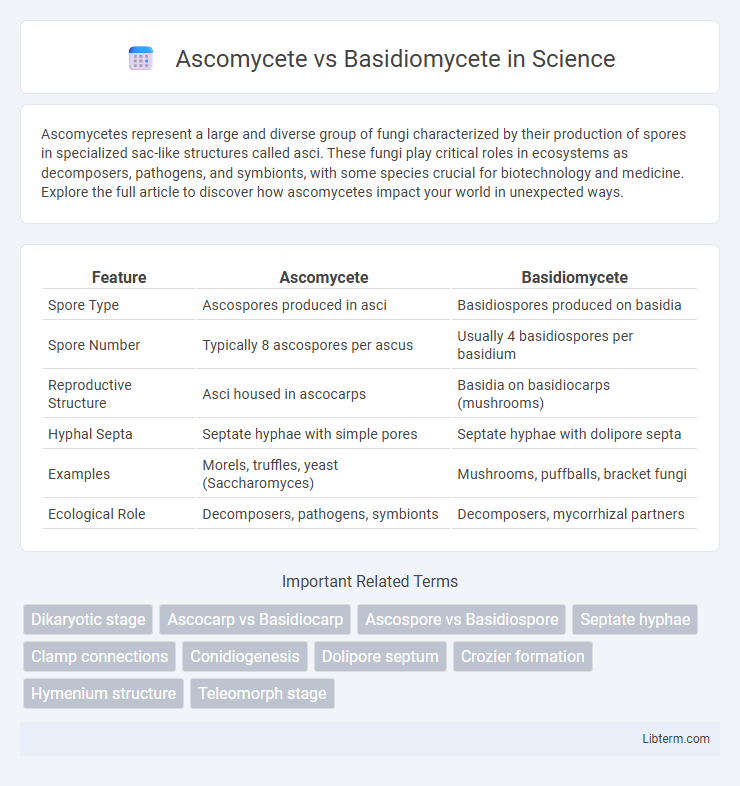Ascomycetes represent a large and diverse group of fungi characterized by their production of spores in specialized sac-like structures called asci. These fungi play critical roles in ecosystems as decomposers, pathogens, and symbionts, with some species crucial for biotechnology and medicine. Explore the full article to discover how ascomycetes impact your world in unexpected ways.
Table of Comparison
| Feature | Ascomycete | Basidiomycete |
|---|---|---|
| Spore Type | Ascospores produced in asci | Basidiospores produced on basidia |
| Spore Number | Typically 8 ascospores per ascus | Usually 4 basidiospores per basidium |
| Reproductive Structure | Asci housed in ascocarps | Basidia on basidiocarps (mushrooms) |
| Hyphal Septa | Septate hyphae with simple pores | Septate hyphae with dolipore septa |
| Examples | Morels, truffles, yeast (Saccharomyces) | Mushrooms, puffballs, bracket fungi |
| Ecological Role | Decomposers, pathogens, symbionts | Decomposers, mycorrhizal partners |
Introduction to Fungal Kingdom
Ascomycetes and Basidiomycetes represent two major phyla within the Fungal Kingdom, distinguished by their reproductive structures. Ascomycetes produce spores in sac-like asci, while Basidiomycetes generate spores on club-shaped basidia. This fundamental difference highlights their evolutionary divergence and ecological roles in nutrient cycling and symbiotic relationships.
Overview of Ascomycetes
Ascomycetes, known as sac fungi, represent the largest phylum within the kingdom Fungi, characterized by the production of spores in specialized sac-like structures called asci. These fungi play essential ecological roles, including decomposition and symbiotic relationships, and encompass economically significant species like morels, truffles, and Penicillium molds. In contrast to Basidiomycetes, which produce spores on basidia, Ascomycetes have a unique reproductive strategy that contributes to their vast diversity and adaptability.
Overview of Basidiomycetes
Basidiomycetes represent a pivotal class of fungi distinguished by their production of sexual spores called basidiospores on specialized cells known as basidia. They include familiar organisms such as mushrooms, puffballs, and shelf fungi, playing critical roles in nutrient cycling and wood decomposition. Basidiomycetes exhibit complex life cycles often involving prolonged dikaryotic stages, contributing to their ecological dominance in forest ecosystems compared to Ascomycetes.
Key Morphological Differences
Ascomycetes produce spores in sac-like structures called asci, typically containing eight ascospores, whereas Basidiomycetes generate spores on club-shaped basidia, often bearing four basidiospores. The hyphal septation of Ascomycetes features simple pores, while Basidiomycetes possess complex dolipore septa with parenthesomes. Fruit body morphology also differs, with Ascomycete fruiting bodies ranging from tiny cups to elaborate structures, and Basidiomycetes forming larger, diverse mushrooms, brackets, or puffballs.
Reproductive Structures and Methods
Ascomycetes produce spores in sac-like structures called asci, typically contained within fruiting bodies known as ascocarps, and reproduce both sexually via ascospore formation and asexually through conidia. Basidiomycetes generate spores externally on club-shaped structures called basidia, usually found on the gills or pores of basidiocarps, with sexual reproduction primarily involving basidiospore development. The key difference lies in the intracellular spore development in asci for Ascomycetes versus external spore formation on basidia in Basidiomycetes.
Life Cycle Comparison
Ascomycetes undergo a life cycle featuring both asexual reproduction through conidia and sexual reproduction involving the formation of asci containing ascospores, usually within fruiting bodies called ascocarps. Basidiomycetes exhibit a life cycle characterized by prolonged dikaryotic stages and sexual reproduction through the production of basidiospores on specialized cells called basidia, typically housed in basidiocarps or mushrooms. Both groups undergo plasmogamy, karyogamy, and meiosis, but the timing, structures, and spore dispersal strategies differ significantly, reflecting their evolutionary adaptations.
Ecological Roles and Significance
Ascomycetes play a crucial role in decomposing organic matter, contributing significantly to nutrient cycling in ecosystems through their saprophytic activities, while many form symbiotic relationships as lichens or pathogens affecting plants and animals. Basidiomycetes are vital decomposers of wood and leaf litter, facilitating carbon cycling and soil formation, with some species forming mutualistic mycorrhizal associations that enhance plant nutrient uptake and ecosystem productivity. Both groups influence forest dynamics and biodiversity by their roles in decomposition, symbiosis, and disease, shaping habitat structure and nutrient availability.
Economic and Medical Importance
Ascomycetes contribute significantly to biotechnology through the production of antibiotics like penicillin and enzymes used in food and beverage industries, while some species cause plant diseases impacting agriculture. Basidiomycetes include edible mushrooms vital to global food markets and are key decomposers in ecosystems, but also harbor pathogens responsible for crop losses and human diseases such as cryptococcosis. Both groups are crucial in pharmaceutical research, with compounds derived from them aiding in the development of antifungal and immunosuppressive drugs.
Common Examples of Each Group
Ascomycetes include common examples such as morels, truffles, and yeasts like Saccharomyces cerevisiae, known for their sac-like asci containing spores. Basidiomycetes feature well-known species like mushrooms, puffballs, and shelf fungi, which produce spores on club-shaped basidia. Both groups play crucial roles in ecosystems, with Ascomycetes contributing to decomposition and fermentation, while Basidiomycetes are key wood decomposers and mycorrhizal partners.
Summary Table: Ascomycetes vs Basidiomycetes
Ascomycetes produce spores in sac-like asci, typically numbering eight per ascus, whereas Basidiomycetes generate spores on club-shaped basidia, usually four per basidium. Ascomycetes include molds, yeasts, and truffles, while Basidiomycetes encompass mushrooms, puffballs, and shelf fungi. The life cycle of Ascomycetes involves the formation of an ascocarp, contrasting with the basidiocarp in Basidiomycetes, highlighting distinct reproductive structures and ecological roles.
Ascomycete Infographic

 libterm.com
libterm.com